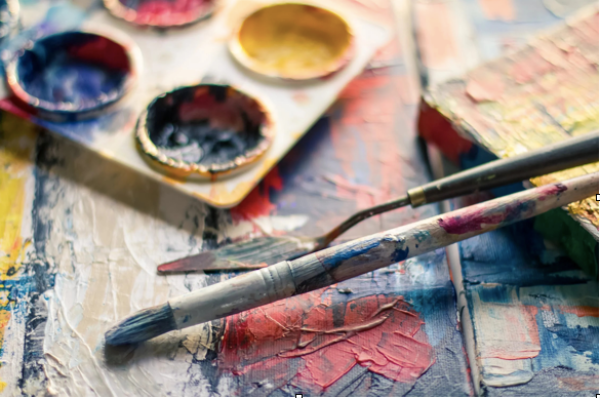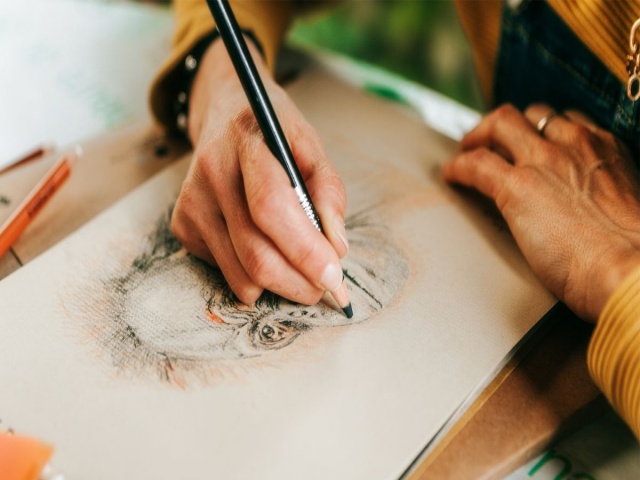Live streaming, as well as video, are two of the most successful ways to make your creative business successful. You can reach the right audience, showcase your artwork, market them, and sell them. But marketing on social media being as competitive as it is, you need to make sure that you make your videos engaging, interesting, and informational.
So, to make sure you can work confidently and efficiently in front of the camera and create captivating art videos, you need to ensure you are maintaining the following steps:

1. Setting Up the Camera
You need to learn how to position your camera to record your drawing, painting, or crafting. You may have tried recording on the table or the ground, with the camera next to you or in front of you, using a whiteboard as the background. You would like to film directly from above, but that requires an expensive desktop monopod. If you attempt it with a tripod, you will end up recording your legs.
The advantage of filming with the camera and tripod in front of you is that they will not be in the way. However, the video might be reversed and the camera will be quite far away, making it impossible to see what you are doing.
Therefore, if you are right-handed, you should initially position the camera on the left side of your body, and vice versa if you are left-handed. By doing so, the tripod becomes less of an obstruction. You can use a table lamp for additional light, but it must also be facing your artwork to prevent shadows.
Another filming technique is to frame the shot such that the subject is on the side, rather than in the center. Thus, if you wish to add text during video editing, you will have a blank space to do so. You also need to make sure your camera is of good quality so that your videos are taken smoothly. In order to do that, you should check out Camera Groove to pick the best camera or the best VPN for photographers
(which is essential, especially if you use public WiFi networks a lot and/or travel a lot). The website also contains a lot of other resources that can help make your videos look more professional and nice.
2. Audio and Voice-Recording
Since you are constructing things with your hands or recording the screen, you are not required to reveal your face or even speak in your films. You can put the relevant directions on the video as well as the caption, but it might be helpful for your viewers to hear the guidelines (and get to know you a little better) in addition to watching you perform the tasks and hearing you read subtitles.
To reduce echo as well as background sound in your voice-over recording, record in a quiet environment and wrap a large towel or blanket around you and your recording device. This prevents the sound from bouncing off the walls and returning to the microphone slightly later, causing an echo.
Narrating the videos can be taxing on your voice, especially when you film for an extended time, so be sure to keep some water and tea handy; lemon or ginger tea is an excellent alternative if you’re seeking something to ease your throat. Additionally, it is expected that you may cough and sneeze at some time throughout filming just pause then keep going. It can be removed.
If you are interested in ASMR videos, you need to realize that they are typically long enough to accommodate mid-roll commercials in addition to pre-roll ads. However, mid-roll advertisements should be avoided in ASMR recordings. People may watch them go to sleep or unwind, so a sudden, loud advertisement in the middle will ruin the experience.
The first time you turn on the camera might seem like stepping onto a stage and then forgetting your lines, but the benefit of filming at your residence or studio is that you can bring notes to help you stay on course.
3. Outlining the Talking Points
Create a list of the main points that you intend to include in your video. This is excellent if you’re presenting a tutorial and wouldn’t want to skip any steps, or if you’re emphasizing a certain product or technique.
If you speak quickly when frightened, you might find it beneficial to speak more slowly. Additionally, do not panic when you make a mistake, the phone rings, and you drop anything. Simply pause, resume where you left off, and remove the gap when editing your video.
Filming with editing in mind is one of my best recommendations for creating art videos. This will become clearer as you create and edit more videos. During the filming process, pause between transitions.
4. Video Editing
You can edit your drawing videos for free with Windows Movie Maker as a novice. Basic functions like adding text, cutting, speeding up or boosting the video’s brightness, and turning the sound down or off work with it. You can search Google for solutions to any error messages you encounter.
Save a video to your computer first (ideally in full HD, 1080p, or the best quality setting available), then upload it to YouTube using the tool provided. Sometimes it helps to split large videos into multiple files, edit those individually, and then put them together if you’re having trouble finishing them. Text captions can also be highlighted to make them easier to read.
If you decide to attempt anything more sophisticated in the future, Adobe offers a 7-day free trial of Premiere Pro, and you can even test-drive Vegas Pro for 30 days without charge. Even older Premiere Pro 30-day free trials are available. The video resolution that can be exported to YouTube with the free edition of Lightworks is limited to 720p or below.
After using Adobe Premiere Pro, you may move to HitFilm 4 Express, a more sophisticated free alternative to WMM that doesn’t impose exporting restrictions on video resolution. Since it’s somewhat comparable to Premiere Pro, learning it will be simple for you if you watch a few tutorial videos and simply Google any questions you have.
Compared to Premier Pro, there are a few problems, nevertheless. HitFilm 4 Express only recognizes true-type fonts; you cannot use open-type fonts. It’s inlined when you outline header text, which occasionally messes up the typeface. And a few other minor problems arise as well.
A more efficient workflow is one significant advantage of using Adobe software. Moving the video between the audio editing program Audition and the video editing program Premiere Pro is simple. You might need to take an extra step to encode files while using open-source software for video or audio editing.
5. Adding Music
Check out YouTube’s Audio Library first for music. You can select royalty-free music from there. Just keep in mind to adhere to the guidelines on the data you must include them in the video description.
However, you may sometimes face bogus copyright claims. Artists who had previously distributed their music for free can later begin charging for it. The safest choices still involve using the YouTube Audio Library, not using any background music at all, or purchasing a music license.
Another alternative is to request permission before using minor artists’ unique music. To prevent YouTube from removing your video for using someone else’s songs, if you come across some music you like, check their About page or video descriptions to see if you can use it. You can also find instructions for getting whitelisted there.
If your YouTube channel is already producing cash for you, you may want to consider subscribing to a royalty-free music library. The free 30-day trial for Epidemic Sound makes it worthwhile to check out. For that month, you are allowed to utilize their music for free in your videos, and even if you later cancel your subscription, the videos you uploaded throughout that month will be deleted permanently. A comparable trial is available from AudioBlocks.
6. Creating a Pre-Filming Ritual
In many cases, the suspense before you begin filming is more terrifying than the actual filming. It’s simple to become anxious about all the potential problems, but if you begin your films with that attitude, no one will be inspired.
Making a relaxing ritual you may perform before each recording session might be a great idea. Simply doing something to relax a little, like listening to your favorite music, meditating for five minutes, or getting a few deep breaths, could be enough.
Final Words
Like painting, the only way to improve at making videos is to practice. Everything you film need not be shared; simply continue improving your craft behind the scenes. Make it a mission to record your artistic process on camera. Share your methods for doing things.
Just go slowly. Start small and implement these suggestions one at a time. You’ll soon feel completely at ease and confident in front of the camera!
